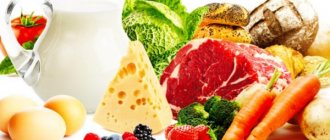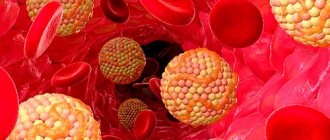Basics
Every person who leads a healthy lifestyle is familiar with this definition. Moreover, he knows about the existence of a food table, which is divided into categories with a low, medium and high glycemic index. Unfortunately, this is where most of our knowledge ends. And this is fundamentally wrong, since such a topic needs to be comprehensively understood, otherwise nutrition will not improve the quality of our life, even with regular training in the gym.
The food we consume consists of proteins, fats, carbohydrates, minerals and vitamins. They are necessary to keep our body healthy. The nutrient content of different foods varies greatly. A person needs balance. Therefore, before creating a diet yourself, you need to obtain at least minimal knowledge in the field of nutrition. You've probably noticed that some foods make a person lose weight, while others can dramatically put on a couple of extra pounds over a period of time.
All our physical activity is interconnected with energy. Nature arranges it in such a way that our body draws it from carbohydrates. When little of them enters the body, during physical activity the body begins to use fat reserves as fuel, and in extreme cases, muscle mass.
As you know, there are simple and complex carbohydrates. They affect the body in different ways:
- Slowly digestible (cereals, legumes, chickpeas).
- Quick (sugar, baked goods).
- Indigestible (vegetables, fruits and bran).
To absorb all the carbohydrates, our body uses a hormone called insulin. It, in turn, distributes all consumed carbohydrates to every cell of our body.
Accordingly, the more carbohydrates you eat, the more insulin your pancreas produces. An excess of this hormone has a negative effect on the body, as it promotes fat storage. This happens due to the fact that nutrients are transported throughout the body, and even into cells where they are not required.
Absolutely any products in which carbohydrates predominate are used as energy fuel only after they are separated into a component - glucose.
It is important to know! Carbohydrates, whether complex or simple, have the same rate of conversion to glucose. Therefore, we will not be able to influence the rate of absorption. Our body doesn’t care whether we eat porridge or honey, an increase in blood sugar will occur after the same period. On average it takes about half an hour.
The concept of the glycemic index
GI is an indicator that determines the number of units of a food that affects blood sugar levels. Accordingly, the simpler the structure of a carbohydrate product, the higher its glycemic index, and the blood sugar level will rise faster.
A person who cares about his health and nutrition is recommended to give preference to foods with a low and medium glycemic index. This choice will protect the body from sudden surges in blood sugar. It is important to understand that the sugar level when consuming fast and slow carbohydrates will be the same. But in the first case it will be accompanied by jumps, and in the second it will proceed gradually.
The glycemic index of foods varies from one to one hundred (where one is the lowest GI value, and 100 is the highest GI value):
- Short. GI less than 55. Practically does not cause fluctuations in blood sugar and insulin. Products of this type are considered the most preferable in proper nutrition.
- Average. From 55 to 69.
- High. From 70 to 100. Provokes a sharp jump in blood sugar levels. A sharp increase in the hormone insulin, which leads to the deposition of fat in the body.
Therefore, you should understand that when consuming a product with a high GI level, you will experience a sharp increase in blood sugar and insulin. After this, you get a decrease in blood sugar, which leads to fat storage and hunger. If you continue to consume foods with a high glycemic index, you may become addicted to sweets. After which a vicious circle arises.
Glycemic index and profile
GI is a value that determines the effect of carbohydrate composition on the period of digestion of food, as well as changes in glucose levels. The maximum level of the indicator is 100. A high load indicator indicates a reduction in the duration of conversion of incoming food into glucose and leads to an increase in blood sugar.
Each product has its own GI, shown in the table:
| Vegetables fruits | |
| Index value | Products |
| 10-15 | Tomatoes, eggplants, all types of mushrooms |
| 20-22 | Radish and zucchini |
| 30-35 | Oranges, carrots, all varieties of apples |
| About 40 | All varieties of grapes, tangerines |
| 50-55 | Kiwi, mango, papaya |
| 65-75 | Raisins, pumpkin, potatoes, bananas, melons |
| About 146 | Dates |
| Flour products and types of cereals | |
| 15-45 | Oatmeal, yeast-free bread, buckwheat porridge cooked in water |
| 50-60 | Dumplings, lavash, black rice, pasta, milk buckwheat porridge, millet cooked in water |
| 61-70 | Pancakes, bread (black), millet cooked with milk, sweet pastries (pies, croissants), watermelon |
| 71-80 | Flour (rye), donuts, bagels, crackers, semolina cooked in water, milk oatmeal |
| 81-90 | Pies, muesli, bread (white), white rice |
| About 100 | Fried pies, baguette, rice flour, semolina (milk), confectionery products, pure glucose |
Products with an insulin index closer to 100 should not be consumed in quantities exceeding 10 g at a time. The glucose index is 100, so all other products are compared to it. The index, for example, of watermelon is significantly higher than the average values, so this product should be consumed with caution.
The glycemic profile requires mandatory monitoring of sugar levels throughout the day. Glucose levels are determined by drawing blood in the fasting state and then after a glucose load. Excess glycemia in most cases is observed in women during pregnancy, as well as in insulin-dependent diabetics.
The glycemic profile reflects the principles of a healthy diet, proving that foods with a high glycemic index increase glucose in the same way as pure sugar.
Indiscriminate consumption of carbohydrates can provoke ischemia, the appearance of extra pounds and the development of diabetes. However, you should not rely entirely on the glycemic index, since not all foods with a high value of this parameter have the same effect on the body. In addition, the index is affected by the method of preparing the product.
Definition
What are GBV products? And why is it necessary to know these values? We can often observe how people, guided by a table of foods with GI values, try to lose weight. This approach, unfortunately, is wrong. It is important to understand that the carbohydrate component differs in food products.
Let's look at an example. The GI of zucchini is 75, and that of sugar is 70. While the share of carbohydrates in sugar is one hundred percent, and in zucchini it is five percent. Accordingly, a person guided by such a table may come to the conclusion that you can gain excess weight from zucchini faster than from sugar. Such disagreements do not apply to all products. This is just an example to see possible inconsistencies.
Therefore, it is important to first familiarize yourself with the GI of the product, and then look at the amount of digestible carbohydrates. It is extremely inconvenient to calculate this value each time. That's why there is a table of products with GN.
Levels
What is GN is now clear. Let's move on to classification. Glycemic load per day is a very important indicator, the determination of which is necessary for the implementation of measures to maintain health, and in some cases, to lose weight.
There is a concept of daily glycemic load. To determine this indicator, it is necessary to make calculations for each product separately. It should be taken into account that it is not worth adding the GN load. It is necessary to use only grams of digestible carbohydrates multiplied by their GI value in the calculation. Divide the resulting value by 100.
Glycemic load per day is classified according to the following data:
- Low load is in the range of values up to 80.
- The average GL ranges from 81 to 119.
- High – over 120.
It is worth noting that here, too, there are disagreements between the indicators. Unfortunately, this situation arose due to the lack of comprehensive research in this area.
The relationship between GI, GN and insulin
Insulin is the main hormone involved in metabolic processes. It is secreted by the pancreas at the moment when blood sugar rises. It acts as the main regulator of metabolism and glucose, which is necessary for the proper metabolism of fats, proteins and carbohydrates.
Insulin lowers blood sugar levels. Principle of operation:
- Eating carbohydrate foods increases the level of the hormone insulin, which in turn lowers blood sugar.
- The more insulin is released, that is, there is an excess of this hormone, the more likely it is that fat will be deposited in the body.
- Glycogen is converted into glucose through the liver. And the more such processes occur, the greater the load on the vital organ.
To avoid health problems, you need to monitor your diet and lead a healthy lifestyle.
Carbohydrate metabolism
The natural process of metabolism of proteins, fats and carbohydrates cannot occur without the participation of the hormone produced by the pancreas - insulin. It is released by the organ at the moment when there is an increase in glucose contained in the blood.
After eating a meal rich in carbohydrates, as a result of their breakdown, a sharp jump in blood sugar levels occurs. In response, insulin begins to be produced, which serves as the key for glucose to enter the body's cells to produce energy.
This subtle and precise mechanism can fail - insulin may be defective (as in the case of diabetes) and not open the way for glucose into the cell, or the tissues that consume glucose do not need such an amount. As a result, the concentration of sugar in the blood increases, the pancreas receives a signal to produce more insulin and works hard, and excess carbohydrates are stored in the body as fat - a strategic reserve in case of nutritional deficiency.
To prevent the negative effects of excess glucose on the body, it is important to monitor its levels.
An example of calculating GN per day
It is important to understand that you need to know your body and its norms. It is not enough to rely on intuition. Once you start making calculations, you will soon feel your normal.
If you are one of those people who do not feel good about their body and cannot create a personal GBV, a simple calculation will help you.
Let's look at an example. Let's say you ate 120 grams of polished white rice. The glycemic index of the product is 60, and GL - 45. Then we tried buckwheat (GL - 28, and GI - 50) and a piece of rye bread weighing 40 grams (GI 50 and GI - 20). And for dessert there is sugar (GI 70, glycemic load is also 70). The weight of the products is calculated from the dry component. If you calculate boiled porridge, you will need many additional recalculations.
Digestible carbohydrates contain:
- Rice cereal contains ninety grams. Based on 75/100 grams.
- Buckwheat contains fifty grams. Based on 55/100 grams.
- There are sixteen grams in a piece of rye bread. Calculated at 40/100 grams.
- There are 25 grams of sugar in 25 grams. The calculation is 100/100 grams.
We calculate the glycemic load for each product separately:
- Rice: 90 x 60 / 100 = 54.
- Buckwheat: 50 x 50 / 100 = 25.
- A piece of rye bread: 16 x 50 / 100 = 8.
- Sugar: 25 x 70 / 100 = 18.
We sum up the indicators and get the number 105.
Important! If you are guided by a table with the GN of food products, pay attention to the method of preparing the specified dish. Usually the indicators of already prepared food are indicated there.
Carefully! High GL foods
Regular consumption of foods with a high glycemic load can lead to diabetes. Therefore, it is so important to build on your daily glycemic load norm. Exceeding the optimal value increases the risk of other serious diseases.
Elevated levels of insulin in the blood can provoke a decrease in “positive” cholesterol and also promote the growth of cancer cells. An increase in triglyceride levels is also not a good sign for your health.
Research conducted in Korea states that daily consumption of white milled rice increases the risk of breast cancer in women by nineteen percent. The same studies were conducted in America regarding foods high in starch. As a result, they confirmed the relationship between the use of such products and relapses of oncological processes.
Diabetes belongs to the category of dangerous diseases. The disease can provoke additional disturbances in the functioning of the entire body. This was confirmed by studies conducted among two categories of people. Some live with diabetes, while others are spared this disease. There is also a theory that the occurrence of cancerous tumors is provoked not by diabetes itself, but by insulin therapy, which is necessary for sick people.
Glycemic load table. What do scientists and nutritionists say?
Diets with a low glycemic load are associated with a reduced risk of heart disease. One of the largest studies was conducted with the participation of 75 thousand women over 10 years. It showed that the glycemic load is one of the determining factors when choosing carbohydrates for nutrition, rather than simply dividing into simple and complex carbohydrates. It has been found that people whose diets are dominated by foods with a high glycemic load have almost twice the risk of heart disease than those who prefer foods with a low glycemic load.
Many nutritionists use the following division for glycemic load (the numbers sum up all meals during the day):
- Low glycemic load - less than 80
- Average glycemic load – 80-120
- High glycemic load - above 120
It is clear that in ordinary life we do not have tables with the glycemic index and load at hand. If there are tables with an index, there are no tables with carbohydrate content. And if there are tables with carbohydrates, then there is no calculator. Therefore, it is worth keeping in mind that most fruits and vegetables contain small amounts of carbohydrates and therefore have a glycemic load much lower than most starchy carbohydrates (rice, pasta and bread).
Knowing and controlling your glycemic load can have a big impact on our health. I have already written about reducing the risk of heart disease. Also, the advantages of diets with a low glycemic load include:
- maintaining stable blood sugar levels
- reducing the risk of insulin resistance and diabetes
- weight control
There are also a number of gastrointestinal diseases in which controlling carbohydrate intake is simply a key factor, but more on that another time.
Level reduction
We have looked at what GN and GI are in products. Can indicators fluctuate? There are many factors that can affect these indicators. The main one is the fiber content of products. The more it is in food, the slower absorption occurs. And, accordingly, the glycemic index is less important.
In addition to fiber, the level of these indicators is influenced by the following factors:
- Heat treatment. Raw vegetables and fruits contain high amounts of fiber. When you sauté or steam food, it loses most of its nutrients. Accordingly, they are considered to be quickly digestible, and their GI becomes higher.
- Very ripe fruit. For example, a banana that is soft and sweet has a higher GI value than a fruit that has a greenish skin and is still quite hard.
- Fats added to foods directly affect blood sugar levels. You need to choose sunflower and olive oil.
- Lemon juice and vinegar reduce the glycemic index of dishes. This is why adding a few drops of lemon juice to cooked food is beneficial.
- Salt and sugar used in cooking increase the GI of the dish.
Interaction between GI and GN
The relationship between these two indicators is that they depend to some extent on carbohydrates. Changes in the glycemic value of a product occur depending on the manipulations that are performed with food. For example, the glycemic index of raw carrots is 35, and after cooking it rises to 85. This shows that the index of cooked carrots is much higher than that of the same raw vegetable. In addition, the size of the GN and GI is influenced by the size of the piece consumed.
The glycemic index value depends on the amount of glucose in food. In most cases, high numbers are observed in fast carbohydrates, which, after consumption, are absorbed in a short time, partially converted into glucose and become a component of body fat.
Types of GI:
- Low - with level up to 55.
- Average – from 55 to 69.
- High index, the value of which exceeds 70.
For people suffering from diabetes, it is important to calculate not only GI, but also GL to normalize glycemia. This will allow you to determine the properties of dishes based on the level of carbohydrates, as well as identify their quantity in each food product.
Do not forget that the method of processing the product during the cooking process changes its parameters and often overestimates the indicators. This is why it is important to eat foods raw. If it is impossible to do without processing, then it would be preferable to boil food products. Most fruits and vegetables contain a lot of fiber and vitamins in their peels, so they are best consumed without prior peeling.
What affects GI:
- The amount of fiber contained in the product. The higher its value, the longer the food is digested and the lower the GI. Carbohydrates are best consumed simultaneously in combination with fresh vegetables.
- Product maturity . The riper the fruit or berry, the more sugar it contains and the higher the GI.
- Heat treatment . Such an effect on the product helps to increase its GI. For example, the longer cereal is cooked, the more the insulin index increases.
- Fat consumption . They slow down the absorption of food, so they automatically lead to a decrease in GI. Preference should be given to vegetable fats.
- Product acid . All products that have a similar taste lower the glycemic index of the dish.
- Salt . Its presence in dishes increases their GI.
- Sugar . It directly affects the increase in glycemic levels and, accordingly, GI.
Index-based nutrition is designed for people with diabetes, as well as those who need to monitor their glycemic levels for various reasons. Such a diet plan is not a fashionable diet, since it was developed by nutritionists not only for the purpose of weight loss, but also to achieve compensation for the underlying disease.
Video about the importance and relationship of nutritional indices:
Is it possible to lose weight with a diet based on GI indicators?
Why is glycemic load important for those who want to lose weight? The norm per day for weight loss varies below 80. It should be understood that the tables, the numbers in which are calculated taking into account GI and GL, are developed for people with diabetes or for those who for some reason need to control their sugar levels blood.
So, before you use medical indicators as another fad diet, think twice. Of course, the list of products can be used by those who closely monitor their diet and health. But remember, if you have normal blood sugar levels, then these restrictions are of no use to you. After all, the menu should be varied. And maintaining or losing body weight can be achieved through physical activity or a slight reduction in daily caloric intake.
If you are nevertheless inclined towards this system, then try to study as much information as possible on this topic, read reviews and download a table of GI and GL for 100 food products.
It is very important to separate the glycemic index from the glycemic load. Because foods with a high GI do not always have a high GI. For example, berries have a high glycemic index, but the glycemic load is low.
What is the glycemic index?
In order to find out when the level of glucose in the blood increases, there is a concept called the glycemic index (GI). It shows how food affects your blood sugar.
Each product has its own indicator (0-100), which depends on how quickly it can increase the sugar content, the table will be presented below.
Glucose has a GI of 100. This means that it enters the blood instantly, therefore it is the main indicator with which all products are compared.
GI has completely revolutionized healthy eating, proving that potatoes and a muffin can raise blood glucose levels in the same way as pure sugar. Consequently, this becomes the cause of ischemia, extra pounds and diabetes.
But in reality everything is much more complicated, because... if you adhere to the GI rule, then a watermelon (GI-75), equal to the indicator of a donut (GI-76), can be classified as prohibited products. But somehow it’s hard to believe that a person will gain the same amount of body fat by eating a watermelon instead of a donut.
This is true, because the glycemic index is not an axiom, so you shouldn’t rely on it for everything!
GBV and sports
Initially, it may seem that an active lifestyle has no effect on the glycemic load of foods. However, it is not.
There is a concept of closing the carbohydrate window. A number of products with high GI and low GL are used for it. Main products in this category:
- Whey Protein.
- Water based gainer.
- Fruit juices.
- Sweet fruits, berries. Most often, preference is given to bananas.
It is worth noting! Our stomach spends enormous resources on foods with a high glycemic index (for the digestion process). Accordingly, it is better to take the opposite approach. We take carbohydrates with a high GN and dilute them with water. This way, you will need less product to close the carbohydrate window. Accordingly, the digestion process will be accelerated, and glycogen replenishment will begin no later than seven minutes later. In a standard situation, it occurs no earlier than twenty to thirty minutes.
But! Products with a low GN index significantly reduce the possible deposition of adipose tissue.
What is glycemic load?
There is also an indicator that helps predict how much blood sugar will rise and how long it will remain at a high level. It's called the glycemic load.
The formula for calculating GL is as follows: GI is multiplied by the amount of carbohydrates and then divided by 100.
GL = (GI x carbohydrates): 100
Now, using this formula as an example, you can compare the GN of donuts and watermelon:
- Donuts GI = 76, carbohydrate content = 38.8. GN = (76 x 28.8): 100 = 29.5 g.
- Watermelon GI = 75, carbohydrate content = 6.8. GN = (75 x 6.8): 100 = 6.6 g.
From this we can conclude that after eating a donut, a person will receive 4.5 times more glucose than after eating an identical amount of watermelon.
You can also use fructose as an example, the GI of which is 20. At first glance, it is small, but the carbohydrate content in fruit sugar is almost 100 g, and the GI is 20.
Glycemic load proves that eating foods with a low GI value but containing a lot of carbohydrates for weight loss is absolutely ineffective. Consequently, your own glycemic load can be independently controlled; you just need to choose foods that have a low GI or reduce the appearance of fast carbohydrates.
Nutritionists have developed the following scale of GL levels for each serving of food:
- the minimum level of GN is up to 10;
- moderate – from 11 to 19;
- elevated – 20 or more.
By the way, the daily GN norm should be no more than 100 units.
Low-carbohydrate diet and GBV
Very often, the glycemic load is used on extreme “cutting” diets. The basis of this diet is a strict restriction of carbohydrates. There is also the option of protein-carbohydrate alternation.
The no-carbohydrate regime involves depleting its own glycogen reserves, transferring the body to the process of burning fat. But with this approach, the lack of sugar in the blood has a negative impact on mood, performance and well-being.
Of course, more gentle diets do not bring the same amazing results. After all, our body has the ability to quickly adapt to a calorie deficit in the daily diet, which leads to a “plateau” effect or a slowdown in weight loss.
You can trick the body by using foods with very low glycemic index and load. Accordingly, the body will use the lack of carbohydrates without restoring glycogen reserves. Your best choice would be foods rich in fiber. All energy will be spent, and fat reserves will be used in anticipation of the next portion of carbohydrates.
By using foods with a high GI and low GN in your diet, you provoke an insulin reaction. After which blood sugar returns to normal, and glycogen is transported into energy. Of course, you need to follow a diet. There should be an excess of protein in the diet, and you will have to eat at least five times a day.
How to lower the glycemic index of foods
There are a number of factors that can influence the GI of products:
- fiber content - the more fiber a product contains, the slower it is digested and the lower its GI. That is why it is recommended to eat carbohydrates in combination with fresh vegetables.
- degree of ripeness - this applies mainly to fruits, berries and fruits. The more ripe the fruit, the more sugar it contains, the higher its GI.
- level of heat treatment - the more heat a product is exposed to, the more its GI increases. This happens because all the “connections” in the structure of the product disintegrate and it enters the body in an already easily digestible form. In cereals, this is due to varying degrees of breakdown of starch structures. The more “boiled” your porridge turns out, the higher its GI.
- adding fat - consuming fat slows down the absorption of foods, correspondingly lowering the GI. That is why you can often hear the following recommendation: “If you want to lower the GI of foods, add fat to them. For example, eat potatoes with butter.” From the point of view of the diet according to the glycemic index, this is quite justified. But consuming animal fats sharply increases the insulin index. Therefore, you should prefer vegetable fats - olive, sunflower and other types of oils.
- acidic foods lower GI. For example, adding lemon juice or vinegar will lower the glycemic index of the dish.
- salt – increases the rate of glucose absorption and, accordingly, a “salty” dish or salty foods will have a higher GI.
- Sugar is glucose, the more glucose, the higher the glycemic index.











